| 
Bufflehead - Part-3 - Cabin and Cockpit
design by Gary Lepak
Part-1 - Part 2 - Part 3 - Part 4
Well, Bufflehead is getting close to launching, but behind schedule as expected. I've been hard at it but you know how these things go. I now have the rudder and daggerboard built and am about to paint. So of course today it has to rain. Oh well, it gave me the chance to finish this report. These pictures show the construction of the cabin, cockpit, and lockers. Comments are below each picture. (click images for larger views)
|
The empty hull after turning right side up and removing the particle board molds. The cedar strip chines are yet to be glassed. The 2x2's hold the shape temporarily until the interior is installed. |
|
The first bulkhead in the bow forms a self-draining anchor locker.
|
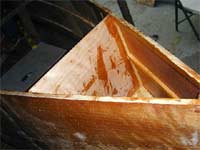 |
|
|
Looking aft, the first piece of 1/2" balsa core is being cut to size. the chines have been glassed with two layers of 6 oz. |
|
 Facing forward, the inside of the forward bulkhead showing an opening for an inspection plate below the anchor well. The balsa core has been covered with plastic sheet and is being vacuum bagged to the bottom. After that cured I glued a layer of 1/4" ply over the balsa to finish the sandwich. This makes the bottom stiff enough to not need any framing for the 6'8" length of the cabin area. The sole/bunk is 6'8" long, about 4'10" wide at the head and 2' wide at the foot. Facing forward, the inside of the forward bulkhead showing an opening for an inspection plate below the anchor well. The balsa core has been covered with plastic sheet and is being vacuum bagged to the bottom. After that cured I glued a layer of 1/4" ply over the balsa to finish the sandwich. This makes the bottom stiff enough to not need any framing for the 6'8" length of the cabin area. The sole/bunk is 6'8" long, about 4'10" wide at the head and 2' wide at the foot. |
|
|
The bulkhead that will form the aft side of the cabin is installed temporarily to hold up the 1x2's that will support the balsa sandwich deck. The center 1x2 will be removed later and the other two left in. There is about 1 1/2" to 5' of camber to the deck. |
|
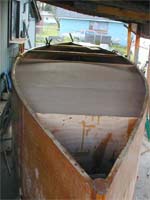 The first layer of 3mm okoume marine ply is layed over the deck supports but glued to the underside of the sheer stringer with a strip of wood glued up under it. The sheer stringer will form a toe rail. There is a 3mm buttblock already glued on the inside of the transverse joint in the deck ply. Then the balsa core is glued down and after that cures, the top layer of 3mm ply completes the sandwich. The first layer of 3mm okoume marine ply is layed over the deck supports but glued to the underside of the sheer stringer with a strip of wood glued up under it. The sheer stringer will form a toe rail. There is a 3mm buttblock already glued on the inside of the transverse joint in the deck ply. Then the balsa core is glued down and after that cures, the top layer of 3mm ply completes the sandwich.
|
|
|
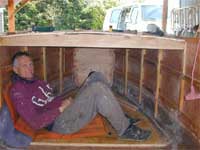 The deck is done. The hardworking boatbuilder takes a well-deserved break in the cabin with the aft bulkhead removed to make deck installation and framing easier. The vertical strips on the topsides are frames made of 1x2s. The edges of the deck and sole sandwiches are visible. Headroom in the cabin is 34" at the sides, plenty for a sloucher like this. I'm quite happy with the size of the cabin. The deck is done. The hardworking boatbuilder takes a well-deserved break in the cabin with the aft bulkhead removed to make deck installation and framing easier. The vertical strips on the topsides are frames made of 1x2s. The edges of the deck and sole sandwiches are visible. Headroom in the cabin is 34" at the sides, plenty for a sloucher like this. I'm quite happy with the size of the cabin. |
|
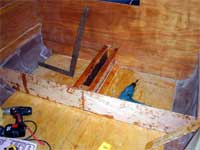 Back to work! The main bulkhead has been glued in. Another layer of 1/4" ply has been glued to the inside of the bottom, making it 1/2" thick. The daggerboard case divides two water ballast tanks that will hold about 22 gallons each. The sole of the cockpit is 8 1/2" above the bottom, and should be a couple inches above the waterline when loaded to max displacement at about 1,800 lbs. The daggerboard case is 24" long allowing for a foam crash block behind the 17" wide daggerboard. A plug will be made to fill the slot flush with the bottom when rowing to cut down turbulence. Back to work! The main bulkhead has been glued in. Another layer of 1/4" ply has been glued to the inside of the bottom, making it 1/2" thick. The daggerboard case divides two water ballast tanks that will hold about 22 gallons each. The sole of the cockpit is 8 1/2" above the bottom, and should be a couple inches above the waterline when loaded to max displacement at about 1,800 lbs. The daggerboard case is 24" long allowing for a foam crash block behind the 17" wide daggerboard. A plug will be made to fill the slot flush with the bottom when rowing to cut down turbulence. |
|
|
The well for the Mirage pedal drive is installed with the removeable box that holds the drive sitting in it. When not in use the well will be plugged at the bottom. |
|
 The cockpit lockers are installed. A 6 gallon water jug here for scale. I may try shifting two 6 gallon jugs of water to the windward side when needed for more righting moment. The Mirage drive well may be handy for other uses. I could stick a handheld depth sounder in there when needed, make a glass bottom box for viewing underwater terrain, fish through it for small fish, dump gray water,
etc. If the Mirage drive proves useless for this size boat I may try a Seacycle or some other unit, or just stick to rowing and close off the well. The cockpit lockers are installed. A 6 gallon water jug here for scale. I may try shifting two 6 gallon jugs of water to the windward side when needed for more righting moment. The Mirage drive well may be handy for other uses. I could stick a handheld depth sounder in there when needed, make a glass bottom box for viewing underwater terrain, fish through it for small fish, dump gray water,
etc. If the Mirage drive proves useless for this size boat I may try a Seacycle or some other unit, or just stick to rowing and close off the well. |
|
|
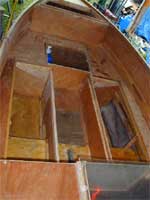 Another view of the cockpit lockers. There is one athwartships at the aft end of the cockpit, then the aft locker to deck level behind that. So altogether there are 6 separate watertight areas to above the waterline, 8 if you count the two water ballast tanks. The worst case would be a flooding of the cabin which is the largest single area of the boat. The locker tops are not waterproof, but will be gasketed and held tight enough to hopefully hold out water long enough for the boat to right itself from a knockdown. Another view of the cockpit lockers. There is one athwartships at the aft end of the cockpit, then the aft locker to deck level behind that. So altogether there are 6 separate watertight areas to above the waterline, 8 if you count the two water ballast tanks. The worst case would be a flooding of the cabin which is the largest single area of the boat. The locker tops are not waterproof, but will be gasketed and held tight enough to hopefully hold out water long enough for the boat to right itself from a knockdown. |
|
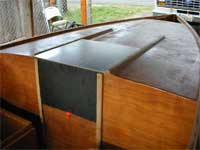 The main hatch and dropboard are made of recycled 1/4" acrylic sheet and pieces ripped from recycled tongue and groove oak flooring. The red webbing strap is for raising and holding the drop board at different levels. The mast is intended to go just to starboard of the hatch, braced against the cabin bulkhead. The main hatch and dropboard are made of recycled 1/4" acrylic sheet and pieces ripped from recycled tongue and groove oak flooring. The red webbing strap is for raising and holding the drop board at different levels. The mast is intended to go just to starboard of the hatch, braced against the cabin bulkhead. |
|
|
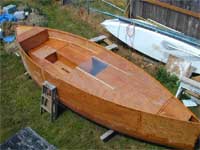 View from the roof. The aft compartment is self bailing, and will hold an anchor and perhaps a collapsed inflatable raft. The bow compartment isn't quite complete in this picture, as there will be a little solid area at the bow with an anchor cleat. View from the roof. The aft compartment is self bailing, and will hold an anchor and perhaps a collapsed inflatable raft. The bow compartment isn't quite complete in this picture, as there will be a little solid area at the bow with an anchor cleat. |
|
|
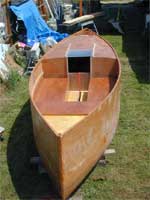 The boat as pictured here weighed 450 lbs, so I expect the added rudder, rig, and daggerboard to bring it up around 550. The boat as pictured here weighed 450 lbs, so I expect the added rudder, rig, and daggerboard to bring it up around 550.
I hope to launch by the end of the month. Theoretically it could float and be rowed now, but I am resisting temptation and will get it painted and at least a rudimentary experimental rig of some sort on it first. |
|
|

